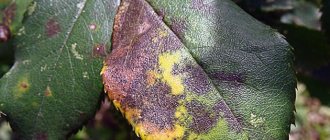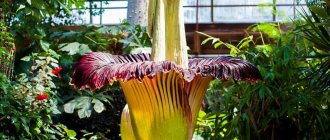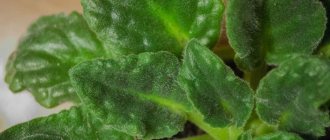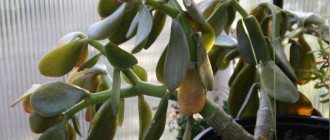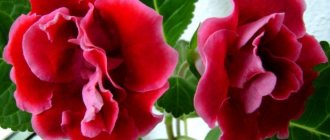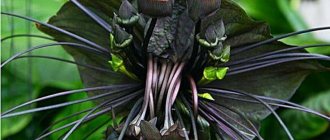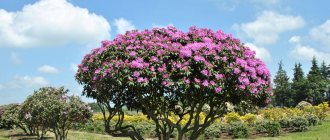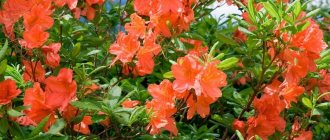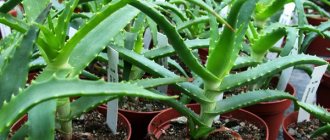Fantastically beautiful and abundantly blooming rhododendron is a decoration for any area. This shrub from the Ericaceae family has dozens of varieties of all bush sizes with beautiful leathery leaves and varied flower colors. And even the tropical origin of the plant does not scare anyone today - many of its frost-resistant forms have been bred.
If you have chosen an acclimatized variety of rhododendron that is suitable for your site, planted it correctly and take care of the plant, does this mean that the shrub is no longer afraid of any misfortunes?
Alas, no - although rhododendron is a crop that is quite resistant to diseases and pests, it can still be exposed to various diseases under poor conditions, improper agricultural practices or the vagaries of the weather. Susceptibility to such negative factors mainly depends on the type and variety of the plant - for example, young and/or depleted rhododendrons growing in full sun rather than in partial shade are most vulnerable.
Poor health of rhododendron is often manifested precisely by modifications of leaf blades - their curvature and/or growth retardation, coupled with new growths of different colors. The leaves of this plant can lose their healthy appearance due to several diseases, mainly of a fungal nature.
Rust
Chrysomyx fungus most often affects small-leaved rhododendrons, although it can also occur on other species.
Symptoms : The infection affects only the crown, without affecting the roots or buds. In autumn, “rusty” yellow, red or brownish dusty swellings (sporangia) appear on the underside of the leaves of affected plants. Severely infected plants drop their leaves prematurely. In spring, dark red spore pads are visible on the leaves - the winter form of the fungus. Without timely treatment, the disease leads to the death of shoots and death of the entire plant.
Control measures : affected leaves are collected and burned. Sick plants are treated with copper-containing preparations. In the early stages of this disease, spraying plants with Bordeaux mixture or its substitutes helps.
Prevention of occurrence : do not create areas near pine forests, avoid excessive application of nitrogen fertilizers, and in the fall carefully remove all plant debris - leaves, broken shoots, fallen fruits.
- Plant rust - signs of the disease and ways to combat it
If the leaves of the plant are covered with spots with a touch of yellow, red, red (less often brown) shades, then most likely the crop has been affected by rust.
Diseases caused by pests
Among this group of diseases, the most intolerable for rhododendrons is the rhododendron bug.
Symptoms of infection are the formation of viscous white traces. Small marks usually appear on the leaves. The bug is destroyed by spraying with diazinon. The acacia false scale is a small insect. They are brown in appearance and oval in shape. The larvae make a hole in the bark with their proboscis, after which they begin to receive nutrients from the stem. After infection, the plant begins to wither - it weakens, loses its former beauty, and after some time dries out. If the rhododendron begins to dry out quickly, it is necessary to treat it once a week with a special product containing organophosphorus substances.
Spider mites are very small insects, and without optical devices it is impossible to see them.
As a rule, the mite infects rhododendrons in hot and dry weather by eating the leaves of the plant. The pathogen is identified symptomatically by external signs - a thin cobweb appears on the underside of the leaves, and the leaf itself becomes brown in color, becomes dull, and possibly falls off. To combat the parasite, it is necessary to use agravertine or diazinon.
Tilled slug. It parasitizes the crown and leaves of young plants. The pest bites into the thickness of the crown, leaving behind significant holes. A slug can destroy a plant very quickly. In order to prevent the plant from being destroyed, the arable slug can be collected manually, or treated with a 0.8% TMTD solution.
The Asian beetleworm is a pest that can cause the most damage to rhododendrons. When infected, the stems and root system are damaged. The leaf is also used as food for the beetleworm. The most effective means of control is diazinon.
The grooved weevil is a small insect with a dark black color. It can cause significant damage to an ornamental plant, and if healing measures are not taken, it can even destroy it. The bug eats foliage, flowers, buds, and in some cases bark. It is especially active in the summer, so at this time it is recommended to treat the plant and soil with bazudin or furadan.
Narrow-winged moth. The larvae (caterpillars) of this moth leave behind a large number of holes, eating through the foliage, after which they “wrap themselves” in a leaf in order to pupate. After some time, the foliage deteriorates - it dries out, crumbles, and falls off. It is recommended to fumigate or treat the bushes with sulfur so that the moths get rid of the smell - thereby preventing the deposition of larvae.
Gastropods. They belong to the genus Helix. Represented by various types of snails and slugs. Capable of destroying different parts of plants - buds, leaves, shoots. These representatives are usually controlled by hand collection, or a variety of molluscicides can be used.
Rhododendron fly - damages the leaves of bush rhododendrons, leaving behind small, light-colored spots. It is a specific pest, that is, one that is unique to this type of plant. In order to eliminate flies, nicotine sulfate should be used by spraying it on the plant.
Septoria spot (small spot)
The Septoria fungus most often “attacks” rhododendrons in greenhouses, although it is also found on deciduous species in open ground.
Symptoms : Small rounded reddish or yellowish-brown spots of irregular shape appear on the leaves, gradually turning white or blackening in the center. Over time, the spots grow, and pinpoint black fruiting bodies of the overwintering stage of the fungus form on their surface. The leaves turn yellow and gradually dry out and fall off. As a result, all physiological processes in plants are disrupted and flower buds do not form normally.
Control measures : affected leaves are collected and burned at the earliest stages of disease development. Sick plants are treated with copper-containing preparations (use only at normal air humidity and a sufficiently high temperature). In the early stages of this disease, spraying plants with Bordeaux mixture or Cumulus fungicide helps.
Prevention of appearance : in the fall, treat the inside surface of greenhouses, dig the soil deeply and carefully remove all plant debris - leaves, broken shoots, fallen fruits.
- Septoria, or white spotting - signs of the disease and methods of treatment
Are the leaves of your plants covered with strange dark spots that are actively growing? It's time to sound the alarm - perhaps it's septoria.
Popular diseases of rhododendrons
Incorrect agricultural technology for growing flowers leads to the development of pathogenic microorganisms. In alkaline soil, the plant quickly becomes depleted, and in wet soil (clay, sand) it begins to become wet, wither and rot. In addition, in open sunny areas, the foliage of the crop becomes covered with burns. Incorrect composition and dosage of fertilizers, as well as strong temperature changes, provoke the occurrence of debilitating diseases and pests of rhododendrons. Treatment and feeding in such cases must be strictly regulated. Moreover, it is necessary to constantly carry out preventive measures to increase the plant’s resistance to infections.
Tracheomycosis wilt or when leaves curl
Fungal microorganisms surprise the root system of the bush, and the underground part begins to rot rapidly. In this state, it is not able to deliver nutrients to the culture.
The first signs of this rhododendron disease are:
- white bloom on the stems;
- brown spots;
- rapid drying of green mass;
- leaf fall (simultaneously with petioles);
- wilting of shoots.
The rhizome is covered with gray-white mycelium. The process of death of living tissue occurs very quickly. The main reason why rhododendron leaves curl is the blockage of blood vessels by fungal spores.
Small tiles in the form of yellow leaves
Alpine flower varieties are especially affected by this virus. Insects, such as aphids or bedbugs, are carriers of dangerous infections.
A photo of this rhododendron disease clearly shows its manifestation:
- yellow-green tint of foliage;
- swollen dark calluses;
- thin leaf plate.
In a short time, the bush transforms into a terrible spectacle. If it is not processed, the disease will quickly spread to neighboring crops.
Spotting is not Variegata
Sometimes the plant sheds its leaves in advance. But before that, it begins to turn yellow and becomes covered with brown spots of complex shape. On dead areas, heavy colonies of spores appear in the form of gray pads.
There are several options for spotting:
- Pestalocia.
- Phyllostictous.
- Anthracose.
- Septoriasis.
For the most part, dry brown spots with a red border appear on the leaves. As the virus progresses, black sporangia appear on the surface. Having become acquainted with photos of rhododendron diseases and their treatment, it will be very easy to cope with a dangerous enemy.
Rot in all its forms
The basis for the appearance and development of fungal diseases of rhododendrons is increased soil moisture.
Eventually brown spots or necrosis appear on:
- young shoots;
- sheets;
- shoots;
- buds;
- roots;
- flower petals.
In advanced forms of fungal infections, a fluffy, smoky coating appears on the leaf blades. Sometimes it acquires a thread-like structure, which resembles a web network.
The best way to combat rot is prevention. To do this, the plantings are sprayed and watered with a 0.2% solution of Fundazol or other copper-containing preparations. Events are held every 2 weeks.
Anthracnose spot
The pathogenic fungus most often affects young rhododendron plants.
Symptoms : On the upper part of the leaves, marginal necrosis appears in the form of brown-brown spots of irregular shape. The leaves gradually dry out. On the surface of the spots, sporulation forms in the form of numerous rounded dark-colored fruiting bodies. If the infection continues to develop, the stems are also affected, which eventually dry out, weakening the plants. The disease is spreading rapidly.
Control measures : pruning and destruction of affected parts of plants, spring spraying with a solution of Bordeaux mixture or Cumulus fungicide.
Prevention of occurrence : do not allow the plantings to become dense, dig up the soil deeply in the fall, treat the inside surface of the greenhouses and carefully remove all plant debris - leaves, broken shoots, fallen fruits.
- Anthracnose: photo and description of the disease, how and how to treat plants
Find out everything about this dangerous disease and how to combat it.
Problem No. 2: the leaves of the Lights series rhododendrons turned red after removing the “scarf”
Details. Many flower growers and gardeners have noticed that after planting, rhododendrons of the designated series sometimes behave in the most unpredictable ways. And it seems that you did everything correctly when planting: you prepared the soil correctly, and you didn’t gut the root ball, but just cut it before planting, and then covered it with a spunbond scarf, and poured humate after planting. Not to mention the fact that he took exceptional seedlings, the quality of which cannot be compromised. And then, after 14 days, you remove the scarf from the exotic plant - and the leaves begin to turn red. What is this: a sore, a pest, an incorrectly chosen location?
What is the reason? In fact, the problem can be quite trivial - a lack of phosphorus. Although many summer residents suggest that the reason is nitrogen, or rather the inability of the plant to absorb it from the soil. But no: phosphorus is to blame. Especially if the summer turned out to be rainy and cool. You probably remember that in such weather phosphorus is absorbed extremely poorly by the roots. Consequently, the plant does not receive enough of it.
Solution to problem #2
To correct the situation and prevent this from happening again, in rainy and cool weather, which lasts not only for several days, but for several weeks, you need to spray with potassium monophosphate. Preparing a solution for treatment is quite simple: just dissolve five grams of monophosphate in a ten-liter bucket of water. By the way, if you manage to get rainwater for this task, it will be great.
There is no need to be afraid of problems. Sometimes symptoms of phosphorus deficiency appear already at the beginning of summer. And this is despite the fact that gardeners and flower growers fertilize the soil in the spring with preparations that have a prolonged effect. Sometimes ordinary horn-hoof meal can give a head start to any foreign preparation, because in the situation with rhododendrons it is much more effective. After such feeding, we recommend carrying out two feeding sessions using potassium monophosphate, and then, when the tree has finished flowering (and this will not happen before the last summer month), dilute eight grams of potassium nitrate in a ten-liter bucket of water and feed the exotic plant again.
It is almost impossible to overfeed plants with phosphorus, unlike nitrogen and other organic matter. Even if there is too much phosphorus in the soil, rhododendron, like any other representative of the flora, will take exactly as much as it needs.
Phyllostictic brown spot
Fungal disease.
Symptoms : Round or irregularly shaped reddening (less often dark gray) spots with a thin dark brown border appear on rhododendron leaves (usually along the edges and ends). Subsequently, the affected areas lighten, crack and fall out. The vast majority of affected leaves die, and the process begins at the tips of the leaves. Black dotted bodies of the overwintering stage of the fungus form on the necrotic tissue.
Control measures : pruning and destruction of affected parts of plants, spring spraying with a solution of Bordeaux mixture or fungicide Cumulus, a suspension of Zineb or Captan.
Prevention of appearance : in the fall, dig up the soil deeply and carefully remove all plant debris - leaves, broken shoots, fallen fruits.
Pestalocia spot
Young plants are also more likely to suffer from the invasion of this fungus.
Symptoms : The fungus affects the leaves and stems of the plant, manifesting itself as small brown spots of irregular shape with a thin brown-yellow border. The spots are often scattered along the edges of the leaf blade, which turns yellow and dries out prematurely. Round gray pads of fungal sporulation form on patches of dying tissue. The spots on the stems are large, depressed, elongated. Over time, their surface dries out and becomes lighter, and numerous small gray pads of fungal sporulation are formed. Affected shoots dry out.
Control measures : pruning and destruction of affected parts of plants, spring spraying with a solution of Bordeaux mixture or Cumulus fungicide.
Prevention of appearance : in the fall, dig up the soil deeply and carefully remove all plant debris - leaves, broken shoots, fallen fruits.
Prevention and plant protection
In summer and spring, plants should be periodically sprayed with insecticides and fungicides. The soil should be moderately moist; plants do not like large amounts of water, but also do not grow in dry places. The soil must have good drainage for growth and flowering to occur.
Note! Most often, rhododendron suffers from a fungal infection. Gardeners prefer to spray the bushes with Bordeaux mixture, which destroys most types of mushrooms.
Rhododendron is often susceptible to diseases, the treatment of which depends on their cause. It can become infected with a bacterial or fungal infection. But the gardener must also take into account that a flower requires certain conditions in order for it to grow and bloom successfully. If the leaves of a rhododendron wither, this article will tell you what to do if you re-read it carefully. And it is advisable not to delay treatment, so as not to lose the entire bush overnight.
Non-infectious chlorosis
This disease, characterized by the appearance of light yellow spots on the leaves of rhododendron, can occur for many reasons - from incorrect agricultural practices to unfavorable soil and climatic conditions (increased soil acidity, deficiency of iron or magnesium in the soil, lack of nitrogen, increased salt content, waterlogging of roots and etc.).
Symptoms : The leaf blade between the conducting veins becomes light green or yellowish-green. In the initial stage of the lesion, the veins still retain a dark green color, later they also turn yellow. With severe chlorosis, all young shoots become yellow or simply pale; they easily get burned in the sun. Constant exposure to unfavorable factors leads to stunted growth and disease, even to the death of the plant.
Control measures : optimization of cultivation conditions - if necessary, liming the soil and/or adding missing elements, etc.
Prevention of occurrence : careful adherence to agricultural cultivation techniques, proper watering, timely fertilizing, normalization of soil acidity.
Wax disease (leaf swelling)
Fungi from the genus Exobasidium parasitize some types of rhododendron, preferring young plants.
Symptoms : deformation, enlargement and thickening of leaves and shoot tips, accompanied by the appearance of large, round or oblong red or red-brown spots. A dense waxy coating of sporulation develops on the surface of necrosis. Over time, the spots dry out and crack, and the spherical growths grow. Affected plants lose their decorative properties and bloom poorly. One type of fungus is also capable of causing the formation of the so-called “rhododendron witch’s broom” with yellowing of the foliage and a powdery coating on the bottom.
Control measures : pruning and destruction of affected parts of plants, spring spraying with a solution of Bordeaux mixture, its substitutes or Cumulus fungicide.
Prevention of appearance : in the fall, dig up the soil deeply and carefully remove all plant debris - leaves, broken shoots, fallen fruits.
Description of the bush
The most beautifully flowering varieties of rhododendrons are called azaleas. They can be deciduous or evergreen. The latter have become widespread in indoor floriculture and are cultivated in greenhouses. Deciduous azaleas are characterized by high winter hardiness, slow growth, a long growing season, and they need acidic soil.
What to do with rhododendron after flowering
For your information! The botanical difference between azaleas and rhododendrons is that azalea flowers have five stamens, while rhododendrons have 7-10.
Many gardeners are interested in how long rhododendrons bloom and whether it is necessary to prune faded flowers of azaleas and rhododendrons in the summer. Flowering of all types is short - 2-3 weeks. Pruning rhododendrons after flowering and during the formation of ovaries is a mandatory measure if the plants are not grown to produce seeds.
Cercospora
The causative agent is the fungus Cercospora. The lower tiers of rhododendron leaves are more susceptible to damage.
Symptoms : Platinum leaves develop irregularly sized, dark brown, angular spots with reddish edges. A gray coating of sporulation appears on the front part of the leaf, clearly visible in humid weather. If left untreated, the disease progresses, the entire reverse side of the leaf turns brown, the shoots stop growing, and flowering does not occur. Without treatment, rhododendron may even die.
Control measures : pruning and destruction of affected parts of plants, treatment of affected plants according to instructions with Alirin-B, in more advanced cases with Ditan.
Prevention of occurrence : mandatory collection and burning of fallen leaves in the fall, loosening the soil after the onset of cold weather.
